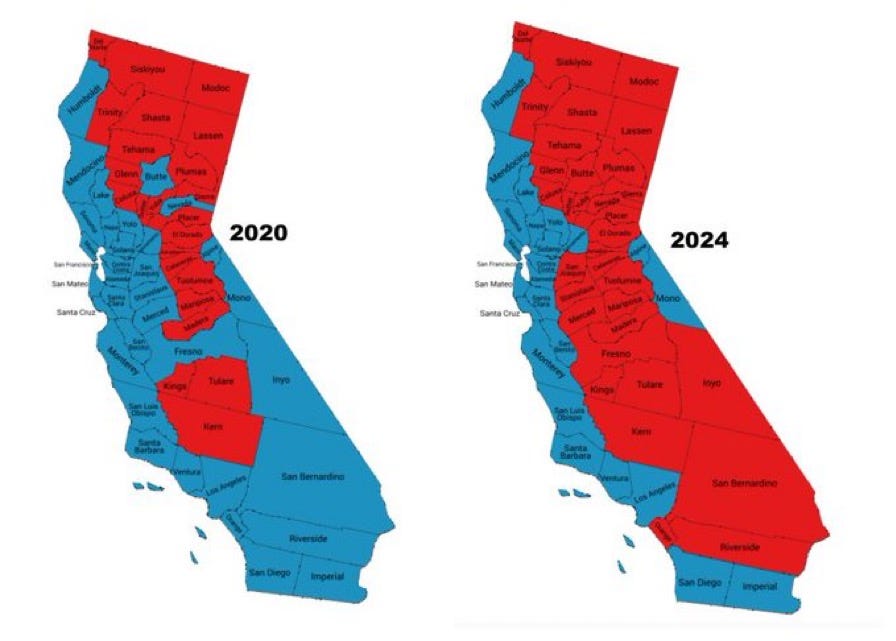CALIFORNIA
Brian Balkus has a great new piece at IM-1776 called Make California Red Again. Balkus does not share the tendency among some conservatives to write off California as a lost cause. (And increasingly, others are offering similar thoughts.)
Balkus says:
It is short-sighted to welcome California’s demise...The future is still invented in California and its influence on global culture remains critically important. California remains one of the most naturally beautiful places on Earth, and its coastal regions boast a perfect climate. On a better timeline California is as close to a utopia as human beings can create.
He goes on to describe a powder keg of optimism in Orange County, and how that region provides a template for the rest of the state:
Travel to [Orange County’s] beach cities, and you won’t find homelessness and filth. Travel through its suburban neighborhoods and you will find safe, tree-lined streets, beautiful parks, and excellent schools.
Orange County works because its elite class carved out a space long ago where they didn’t have to deal with Los Angeles politics. The answer to fixing California is to make more places like Orange County, and less like Los Angeles, with a kind of coastal-infused Republicanism taking hold.
Balkus identifies three steps for reclaiming the Golden State:
Ballot Initiatives: Use the state’s steroidal version of direct democracy, i.e., ballot initiatives, to implement mass change. “What about a ballot initiative to ban public sector unions completely?” he writes. “Or an initiative to choke-off funding to the Democrat-aligned ‘non-profits’?”
Relentless Ground Game: Embrace the state’s penchant for rewarding committed activism. “In 2019,” he writes, “the Democratic Socialists of America of Chicago…identified areas of [Chicago] that would be receptive to their message and executed a relentless political ground game in order to get out the vote for their candidates. This success was achieved despite the fact that the Chicago chapter of the DSA only has 3,300 members in a city with a population of 2.7 million.”
Secession Movements (or the Threat of Secession): Carve out wins by threatening secession movements. Balkus cites a clever stance taken by the San Fernando Valley in 2002, when its residents brought a secession initiative to the ballot. “Although this initiative ultimately failed,” he writes, “the City of Los Angeles responded to the effort by adding a city council member to represent the Valley, opening a major municipal building in the area, along with 35 new public schools, and opening the Metro Orange Line to provide mass transit options. Secession movements don’t have to succeed to matter. The mere threat of taking away tax revenue often works to gain leverage.”
I would add a few other pieces to Balkus’s plan.
First, feed the red war chest by impressing a new and emergent donor class with gains and momentum, which becomes self-perpetuating.
Fill Republican seats everywhere that it’s possible to do so, and run as nominal “independents” in solidly blue districts that might be susceptible to red messaging, e.g., wine country, where there is agriculture, natural resources, and old money.
Focus on districts and counties — not municipalities, towns, or cities. Force Dems to earn every single vote and do not allow them to take anyone’s constituency for granted.
Once elected, proceed to act “red” through and through. In incremental fashion, move Dems slightly rightward; create an environment where any electoral loss is a defacto win. This is the Dems’ own playbook — a well-funded and ruthlessly efficient machine.
None of this would be easy — the state’s bureaucracy is a nightmare — but California is the prized Rothschild Egg. It must be reclaimed. The situation is urgent. And, as Donald Trump and Elon Musk have demonstrated, achieving the impossible is the only realistic ambition in our current moment.1
EL SEGUNDO
Relatedly, I recommend this Vanity Fair piece on some interesting things happening in El Segundo, and specifically the following passage:
At the offices of the nuclear energy company Valar Atomics, where I was invited to attend a Bible study, Bibles were propped up on desks beside laptops. Valar Atomics’ head of business operations, Elijah Froh, who is 26 years old and has the straightforward self-assurance of a car salesman, offered me a glass of raw milk, increasingly the drink of choice in many conservative circles. Then, he led our small group in prayer and read aloud from a passage in Hebrews.
Later, Froh invited me into Valar Atomics’ cigar lounge, where actual cigars can’t be smoked due to a permitting issue with the building. We sat in enormous leather armchairs beside a small table stacked with cigars sealed in Ziploc bags. On the wall hung four large classical paintings depicting Columbus discovering America, the pilgrims arriving on the Mayflower, the signing of the Declaration of Independence, and the Constitutional Convention. Froh told me that God needed businessmen just as much as he needed missionaries, and that God had put him on this earth to build a nuclear energy company.
ADMINISTRATUM
Also in Southern California, K-Capital’s Alex Green recently unveiled Administratum, his vision for how America can maximize human flourishing and move toward the stars, via a two-pronged approach:
Automation of infrastructure development; and
Driving down the cost of commodities and resources to near-zero.
Green holds that these are highly bounded mathematical problems to solve that must be offloaded to agents serving the broader purpose of humanity. His thoughts are fleshed out more here, with a Nick Land primer embedded below.
In short, the task requires treating data and computation as commodities, akin to how crude oil is refined. The key points:
Cost of Computation: While compute power has become drastically cheaper over the years, demand (especially from AI) has outpaced supply.
Commodification Needs: Cloud services like AWS and Azure operate in silos, binding users to a single provider, which limits flexibility and affordability.
Solution via Market Dynamics: Commodification would allow users to buy compute power in a spot market, and would enable price flexibility and better scaling options.
Profit Model: Beyond commodification, a derivatives market for compute (consisting of options, futures, swaps) would operate similar to traditional commodities markets. This nexus would foster price stability, liquidity, and profit opportunities from financial and technical services in an open compute marketplace.
Companies that are working on the problem of commodifying data and computation include Valdi.

NEWS & NOTES
WINTER NATURAL GAS OUTLOOK: Earlier this fall, the U.S. Energy Information Administration predicted that natural gas consumption would be slightly higher than last winter due to colder weather (but prices would be lower, particularly in the West, where NG bills would be about 6% less than 2023-2024). The average futures price for winter is currently 38.6% lower than this time last year at SoCalGas’s Citygate and 33.9% lower at PG&E’s Citygate.
Meanwhile, the International Energy Agency says that, while NG prices are expected to be relatively stable this winter, various international events bear close scrutiny, e.g., the transit and interconnection deals between Russia and Ukraine at the end of 2024. If these deals are not renewed or replaced, Russian gas flows to Europe via Ukraine would end, placing upward pressure on international liquefied natural gas markets in January.
Per Rigzone, NG prices were rising on Monday — possibly due to multiple factors, e.g., weather conditions, reduced wind generation creating a shortfall that is filled by NG, the start of seasonal storage inventory withdrawals, and a slight decrease in NG production.
LOW CARBON: Last week, the California Air Resources Board (CARB) approved updates to the Low-Carbon Fuel Standard,2 raising carbon intensity reduction targets from 20% to 30% in 2030 and to 90% by 2045. The end result could be gas-price increases ranging from 47 cents per gallon to 65 cents per gallon.
These regulatory manifestations of the state’s animus toward fossil fuels will have to abate at some point — note that California’s use of petroleum is actually increasing while EV sales are leveling off. The state needs its refineries, especially in light of Phillips 66’s planned closure next year, which will drop state refinery capacity to 1.48 million barrels per day and leave it at only 2.3% in excess of average demand.
It seems likely that, eventually, Governor Newsom will have to work with the fossil-fuels industry,3 the same way he had to pivot and extend operations at Diablo Canyon, lest his own political future collapse into quicksand. (If Newsom isn’t careful, Valero may follow P66 out the door.)
Even liberal policy wonks have arrived at the conclusion that California needs to decide whether it wants low carbon OR low gasoline prices. “There is a legitimate debate to be had,” writes James Bushnell, “about how aggressive California should be in pursuit of net-zero GHG if it finds itself largely alone in such a quest.”
For more on CARB’s thicket of administrative complexities, see this Ed Ring piece.
DISTRIBUTED ENERGY RESOURCES: At its November 7 business meeting, the CPUC made updates to the “Avoided Cost Calculator,”4 a tool used by the agency to evaluate the cost-effectiveness of distributed energy resources. Canary Media provides a helpful explainer on the ACC here. In short, the ACC is a set of spreadsheet formulas that the CPUC once used to assess energy-efficiency programs but now uses to assess the value of all DERs, including those that supply power to the grid, e.g., solar panels and batteries. The latest updates to the ACC are available here and involve greater harmonization with the CPUC’s Integrated Resource Planning proceeding, among other changes.
FEDERAL ENERGY REGULATORY COMMISSION: At a recent FERC conference on grid reliability, FERC board member Mark Christie identified three factors driving reliability concerns: (i) the loss of such baseload resources as coal and gas; (ii) an inability to build equivalent new resources in timely fashion; and (iii) an explosion of new demand. “This crisis is coming fast,” said Christie. “Reality is tracking us down.”
ELECTRIC VEHICLES: California-based Aptera Motors has run a low-speed demo of its solar EV, which is designed for daily driving minus the need to charge.
LINKS
Atomic Age Catholics (h/t Nuclear Barbarians): “In the fall of 1957, an AGN-201 nuclear training reactor was installed on the Catholic University campus. Originally located in the Nuclear Training Laboratory of the campus Power Plant, this reactor was a compact unit standing nine feet tall and weighing 12 tons. Capable of producing 100 milliwatts of energy – only enough to light a single Christmas tree bulb! – the unit was not intended for powering campus offices but providing a controlled model to train budding nuclear engineers, power plant operators, and faculty researchers. For over 20 years, the reactor was at the heart of a close relationship between the Atomic Energy Commission and the University. But why Catholic University and why a nuclear reactor?”
Requiem for the Hoover Dam: “It is fitting that the ferocious genius loci of the Wild West would inspire its own distinctive technological Colossus, the hydroelectric dam. In Man and Technics, Oswald Spengler defines the Faustian spirit as a will to transform the world ‘by the force of its practical energy and the gigantic power of its technical processes.’ Dynamism is the essence of Western technics, which is concerned ‘not with stuffs, but with forces,’ and with the practical conversion of force to ends, and the multiplication of man’s ends.”
Time for Think Tanks to Think Again: “…why is Net Zero required? It is a manifestation of the ‘Mitigation Strategy’ to combat climate change, but why is mitigation the best strategy? For mitigation to be effective, it requires CO2 to be the only influence on climate change and for every other country to be reducing emissions to zero. Neither condition is being met and the risks of Net Zero ‘cure’ are far higher than the supposed climate change ‘disease.’”
Trump as the Last Warrior of the West: “[Author Constantin von Hoffmeister] portrays Trump as someone whose thoughts parallel Guillaume Faye’s concept of Archeofuturism. Roughly, Faye argued that striving for a distant future and returning to tradition are not, and must not be, contradictory, but should be united. Many American writers view science fiction, such as Dune, Star Wars, Nausicaä of the Valley of the Wind, or Legend of the Galactic Heroes, as expressions of this Archeofuturism. The author sees Trump’s internet-driven influence and the renewed large-scale interest in thinkers like Evola among Trump supporters during his campaign as signs of Archeofuturism. Trump’s position as an entrepreneur is interpreted similarly. (It is worth noting that in the Austrian School, the market is essentially a massive competition to find the most efficient solution to a technical problem. This is why thinkers like Nick Land believe that the market drives machines to develop increasing intelligence.)”
Why is Grid Inertia So Important? “…synchronous generation provides the ‘muscle’ for a power grid. A proposed theoretical model for grid-forming [inverter-based resources] requires huge energy storage devices that mimic the functionality of large synchronous generators. (These proposed devices do not yet exist.) Despite the fervent wishes of renewable power advocates, synchronous generation will be a necessary part of power grids for the foreseeable future. [The Diablo Canyon Power Plant] will continue to be needed.”
Why So Few Matt Levines? “Matt Levine is the most well-known newslettrist (‘Money Stuff’) in the financial industry, having blogged or written since 2011, finding his niche in popularization after stints in Wall Street & law. He is read by hundreds of thousands of readers…One might ask (and indeed, a billionaire once did), ‘where are the other Matt Levines?’ or ‘who are the Matt levines of other fields?’…Why don’t we have a Matt Levine for every industry? Where is the Levine of, I don’t know, petroleum refining or fracking, of shipping containers?”
Per Forbes — California’s LCFS requires gasoline producers to reduce the carbon intensity of the fuels they sell — this can entail blending more expensive biofuels, investing in cleaner production technologies, or buying credits from other companies to meet carbon intensity reduction targets. LCFS compliance costs are reflected in the price of gasoline.
California’s oil output has decreased 35% since Newsom took office in January 2019.
The ACC calculates seven types of avoided costs: generation capacity, energy, transmission/distribution capacity, ancillary services, the Renewables Portfolio Standard, greenhouse gas emissions, and high global warming potential gases. The outputs of the ACC feed into the CPUC’s cost-benefit analysis for DERs.






